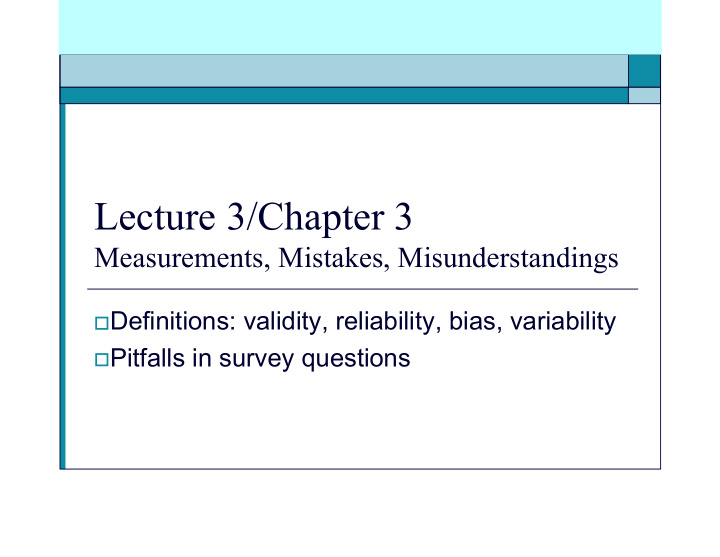



Lecture 3/Chapter 3 Measurements, Mistakes, Misunderstandings Definitions: validity, reliability, bias, variability Pitfalls in survey questions
Definitions (variables) Categorical variable : one whose values are qualitative (like gender) Quantitative (measurement) variable: one that takes number values with arithmetical meaning (like height) Discrete quantitative variable: one with distinct possible values like the counting numbers Continuous quantitative variable: one whose possible values fall over a continuous range
Definitions (measurement) Valid measure: measures what it’s supposed to; “on target” Reliable measure: gives consistent results Biased measurement: systematically underestimates or overestimates (can prevent it from being valid) Variability of measurements : may result from measurement error & be associated with unreliability Natural variability: how individuals are inherently different from one another
Example: Invalid or Unreliable? Background : A hospital patient who’s been losing weight is evaluated with a calorie count; nurses record how many calories are on his meal trays, not how many he consumed. Question: Is the problem with this measure that it’s invalid or unreliable? Response:
Example: Invalid or Unreliable? Background : A patient’s blood pressure is measured 3 times in a row by the same nurse; the top numbers (systolic) are 160, 142, 155. Question: Is the problem with this measure that it’s invalid or unreliable? Response:
Example: Another Measurement Problem Background : A height chart is accidentally hung so the bottom is 1/2 inch above the floor. Question: What do we call the resulting measurements? Response:
Example: Type of Variability Background : A nurse records blood pressure for 3 patients; top numbers are 160, 142, 155. Question: Should we attribute the difference to unreliable measurements or natural variability? Response:
Example: The Role of Natural Variability Background : A manufacturer wants to compare mileage obtained with 2 types of gas. Question: If there is only a slight difference between the 2, is it easier to detect if they’re tested on very similar or very different cars? Response:
Pitfalls/issues in survey questions Deliberate bias 1. Unintentional bias 2. Desire to please 3. Asking the uninformed 4. Unnecessary complexity 5. Ordering of questions 6. Confidentiality/anonymity 7. Open vs. closed questions 8.
Example: Identifying type of bias Background : A man with a clipboard stopped a pedestrian, asking “Do you smoke? No? Good, then would you sign this petition to keep smokers away from non-smokers in the workplace?” For the next, it was, “Do you smoke? Yes? Good, you can win a free pack of Kools if you sign this petition to provide for designated smoking areas in the workplace.” Question: Was this deliberate or unintentional bias? Response:
Example: Identifying direction of bias Background : A USA Today survey of 102,263 randomly selected adults reported 87% rated their own health as “good” to “excellent”. Question: Does 87% seem surprising? Does it seem like an underestimate or overestimate? Response:
Example: Identifying source of bias Background : A USA Today survey of 102,263 randomly selected adults reported 87% rated their own health as “good” to “excellent”. Options given were: excellent, very good, good, fair, poor Question: Now are you surprised? Was the bias deliberate or unintentional? Response:
Example: Identifying source of bias Background : Gallup Nov. 2008 survey question: Question: Why was the question worded this way? Response:
Example: Identifying source of bias Background : Gallup question about gun ownership Question: What response options should be given? Response:
Example: Identifying source of bias Background : Gallup question about gun ownership Question: Which pitfall was Gallup avoiding? Response:
Example: Identifying source of bias Background : A personality test asks, “Do you sometimes find that you have arguments with your family members and co-workers?” Question: How could this question be improved? Response:
Example: Identifying source of bias Background : A survey asked: How happy are you with life in general? (a) How often do you normally go out on a date? (b) Question: Would it matter if order were switched? Response:
Example: Identifying source of bias Background : Consider article about National Survey of Adolescent Males. Question: If researchers seek honest answers to questions about risky or socially unacceptable behavior, should they use a pencil-and-paper or computer survey? Response:
Example: Identifying source of bias Background : Two possible exam questions: What kind of question is this? (a) open (b) closed 1. What is an open question? 2. Question: Answer the above; what are the relative advantages of closed and open questions? Response: Closed questions are Open questions are
Example: Objectionable survey questions Background : School survey: Question: Why did parents object to the survey? Response:
Example: Objectionable survey questions Background : School survey: Question: Why were the questions worded this way? Response:
Example: More on School Survey Background : Question: How could this question be improved? Response:
We’ll identify units, population, etc. in the context of this article: ALCOHOL DATA SHOWS LITTLE CHANGE A new study of alcohol use among college students has found that the prevalence of binge drinking at UW-Madison remained largely the same over the past year, reflecting a national trend. Conducted by Henry Wechsler and the Harvard School of Public Health, the 2001 College Alcohol Study found continued high rates of binge drinking and the associated negative consequences at UW-Madison and colleges and universities across the nation… At UW-Madison, 66% of respondents said they had engaged in binge drinking in 2001, compared to 62% in 2000 and 67% in 1999. Binge drinking is defined as 5 drinks or more in a row for men and 4 drinks or more in a row for women. However, the changes are not statistically significant because of the margin of error built into the study. The 2001 numbers are based on a sample of 400 students.
EXTRA CREDIT (Max. 5 pts.) Find a survey question on the internet or elsewhere, and write a paragraph or two discussing whether or not each of the pitfalls applies.
Recommend
More recommend